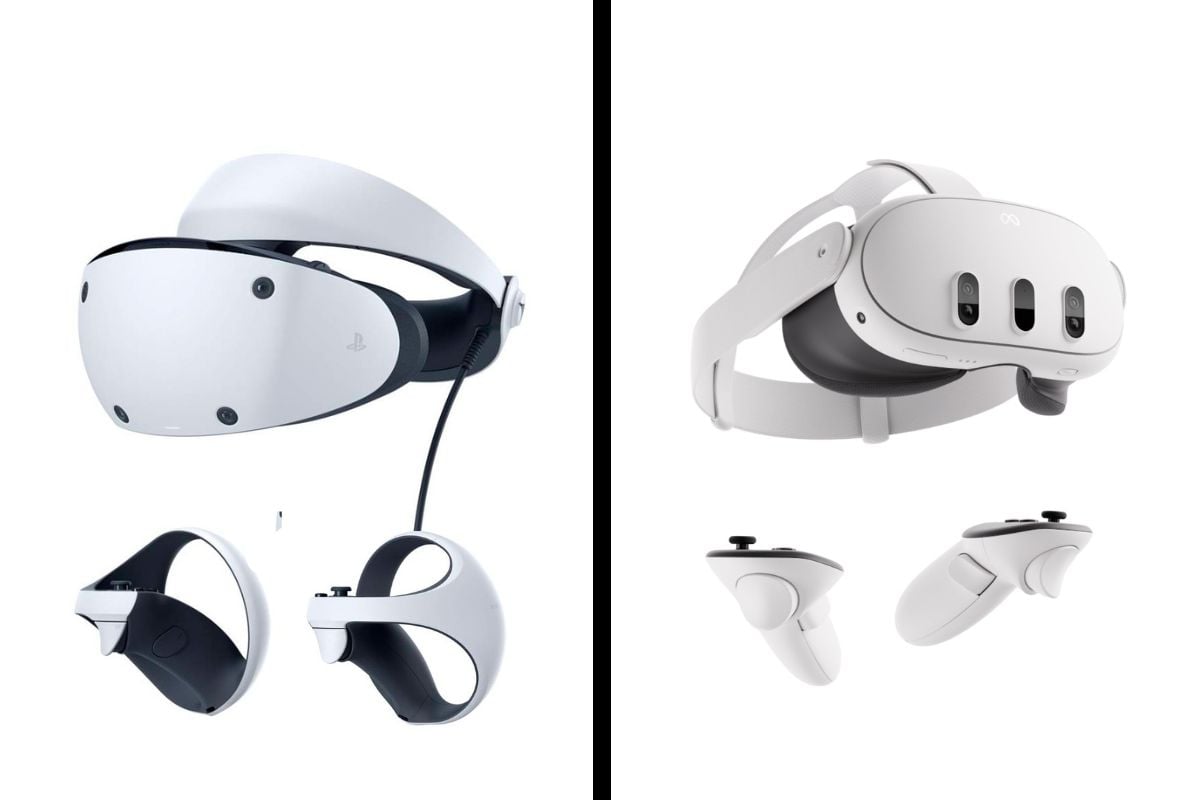Selecting the perfect VR headset is crucial for users interested in immersive experiences like gaming or VR porn. Two prominent contenders in this space are Sony’s PlayStation VR2 (PSVR2) and Meta Quest 3. Each headset brings unique strengths and weaknesses across various features, such as processing power, display quality, design, and comfort, among others.

This comparison between PSVR2 and Meta Quest 3 will help you understand their relative strengths, so you can decide which one suits your needs in the rapidly growing world of virtual reality.
Processor and Performance
PSVR2: The PSVR2 is powered by the PlayStation 5, utilizing the console’s robust hardware, including the AMD Zen 2 processor and RDNA 2 GPU, which handle VR environments with high graphical fidelity and smooth performance. This setup ensures the ability to render complex, high-detail VR content effectively.
Meta Quest 3: Equipped with the Qualcomm Snapdragon XR2 Gen 2 chipset, the Meta Quest 3 boasts a significant leap in processing power compared to its predecessor, the Quest 2. This next-generation processor provides enhanced performance, better graphics rendering, and smoother multitasking, making it ideal for standalone VR gaming and experiences.
Conclusion: While both headsets offer powerful performance, Meta Quest 3 stands out for its portability and capability to deliver high-end VR experiences without needing an external console. However, PSVR2, when paired with the PS5, can handle more graphically intensive games.
Display and Visual Experience
PSVR2: Sony’s PSVR2 features a stunning OLED display with a resolution of 2000 x 2040 pixels per eye, delivering 4K HDR visuals at up to 120Hz. The OLED technology ensures deep blacks and vibrant colors, enhancing the overall visual experience. Additionally, the PSVR2 offers a 110-degree field of view, providing an expansive and immersive viewing angle.
Meta Quest 3: The Quest 3 offers a resolution of 2064 x 2208 pixels per eye through its LCD display, called “4K+ Infinite Display,” which provides excellent visual clarity with 1218 pixels per inch (PPI). The pancake lenses improve image sharpness, reducing glare and distortion. With a refresh rate of up to 120Hz, users enjoy fluid and responsive visuals.
Conclusion: Both headsets provide impressive visual experiences. PSVR2’s OLED display offers better contrast and vibrant colors, while Meta Quest 3’s LCD screen delivers slightly higher resolution and PPI. The choice comes down to a preference between OLED’s color depth versus LCD’s crispness.
Design and Comfort
PSVR2: The PSVR2 has a well-balanced design with an adjustable halo strap that distributes weight evenly across the forehead, enhancing comfort during prolonged use. The ergonomic setup allows users to wear glasses comfortably, and the single USB-C cable connection keeps setup simple, although it limits freedom of movement compared to wireless options.
Meta Quest 3: Meta Quest 3 is 40% slimmer than Quest 2, featuring a lighter, more streamlined design that is both comfortable and portable. The new lens distance adjustment wheel ensures a better fit for different users, while the redesigned controllers are more ergonomic, enhancing the overall user experience.
Conclusion: Meta Quest 3 takes the lead in terms of comfort and design due to its wireless setup and lighter build. However, PSVR2’s head-mounted design is also very comfortable for extended sessions, especially for PS5 users.
Connectivity and Battery Life
PSVR2: The PSVR2 connects directly to the PS5 via a USB Type-C cable. While this wired connection provides a stable and consistent experience, it restricts mobility. Since it draws power directly from the PS5, there’s no concern about battery life.
Meta Quest 3: Being a standalone device, Meta Quest 3 offers Wi-Fi 6E and Bluetooth 5.2 connectivity, making it more versatile. It has a battery life of up to 2.9 hours, which is decent for a standalone VR headset. However, it does require recharging after extended use.
Conclusion: Meta Quest 3 provides more flexibility with its wireless design, but PSVR2 benefits from a constant power supply from the PS5. Your choice here depends on whether you prefer a wireless setup or don’t mind being tethered to a console.
Tracking and Interaction
PSVR2: PSVR2 offers inside-out tracking with four embedded cameras on the headset, eliminating the need for external cameras. It also features advanced eye tracking and headset haptics, which add a new level of immersion by responding to in-game events.
Meta Quest 3: Meta Quest 3 also supports inside-out tracking with six new camera sensors that enable precise room mapping and hand tracking. The full-color passthrough and mixed reality capabilities offer a unique experience that blends VR and AR seamlessly.
Conclusion: Meta Quest 3 excels in mixed reality and hand tracking, providing a versatile VR and AR experience. However, PSVR2’s eye tracking and haptic feedback offer a different layer of immersion that is particularly impactful in gaming.
Additional Features
PSVR2: One of PSVR2’s standout features is its integration with PlayStation 5 games and services. The single-cable setup makes it easy to use, and the platform supports a wide range of games and experiences, including VR porn, thanks to its compatibility with various content platforms.
Meta Quest 3: Meta Quest 3 offers advanced features like Direct Touch hand tracking, full-color passthrough, and superior audio performance with 3D spatial audio. The new controllers also feature TruTouch haptics, enhancing the tactile experience.
Conclusion: Meta Quest 3 offers a broader range of advanced features for mixed reality and interactive experiences. However, PSVR2’s ecosystem is more gaming-centric, with unique haptic feedback and PlayStation integration.
The Bottom Line
Both headsets have distinct advantages: PSVR2 excels in visual quality and PlayStation integration, while Meta Quest 3 offers superior mixed reality capabilities and standalone functionality. The best choice depends on what you value more—advanced mixed reality features and portability (Meta Quest 3) or deep integration with a gaming console and enhanced visual immersion (PSVR2).